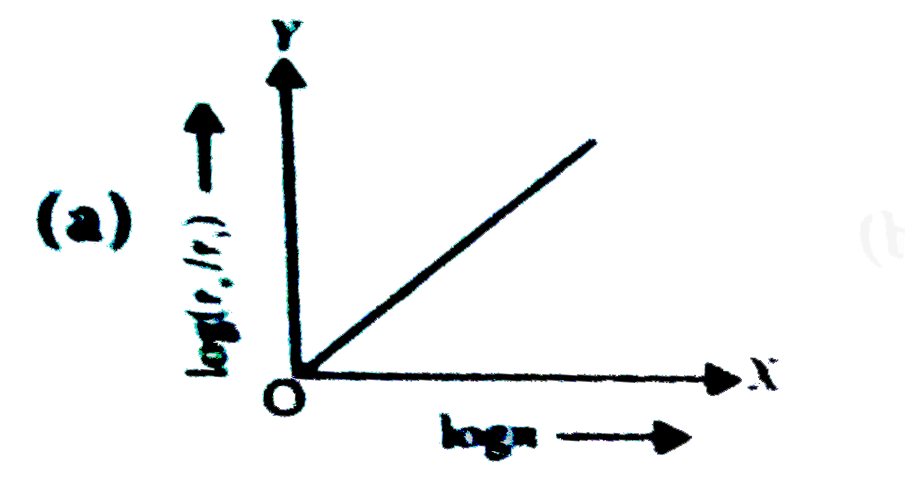In a hydrogen atom, the radius of nth bohr orbit is rn. The graph between log (rn/r1) and logn will be




The correct Answer is:A
To find the graph between log (rn/r1) and log n for a hydrogen atom, we can follow these steps:
Step 1: Understand the relationship between the radius of the nth orbit and the first orbit
The radius of the nth orbit rn in a hydrogen atom is given by the formula:
rn=n2r1
where r1 is the radius of the first orbit.
Step 2: Express rn/r1
From the formula above, we can express the ratio of the radii:
rnr1=n2
Step 3: Take the logarithm of both sides
Now, we take the logarithm of both sides of the equation:
log(rnr1)=log(n2)
Step 4: Apply the logarithmic identity
Using the logarithmic identity log(ab)=b⋅log(a), we can simplify the right side:
log(rnr1)=2⋅log(n)
Step 5: Rearranging the equation
This can be rearranged to show the relationship between log(rnr1) and log(n):
log(rnr1)=2log(n)
Step 6: Identify the graph characteristics
This equation is in the form of y=mx, where y=log(rnr1), x=log(n), and m=2. This indicates that the graph will be a straight line passing through the origin with a slope of 2.
Conclusion
Thus, the graph between log(rnr1) and log(n) is a straight line passing through the origin with a slope of 2.
---
The radius of the nth orbit rn in a hydrogen atom is given by the formula:
rn=n2r1
where r1 is the radius of the first orbit.
From the formula above, we can express the ratio of the radii:
rnr1=n2
Now, we take the logarithm of both sides of the equation:
log(rnr1)=log(n2)
Using the logarithmic identity log(ab)=b⋅log(a), we can simplify the right side:
log(rnr1)=2⋅log(n)
This can be rearranged to show the relationship between log(rnr1) and log(n):
log(rnr1)=2log(n)
This equation is in the form of y=mx, where y=log(rnr1), x=log(n), and m=2. This indicates that the graph will be a straight line passing through the origin with a slope of 2.
Thus, the graph between log(rnr1) and log(n) is a straight line passing through the origin with a slope of 2.
Topper's Solved these Questions
- ATOMS BOOK - NCERT FINGERTPS ENGLISHCHAPTER - ATOMS EXERCISE - Higher order thinking skills
8 Videos
- ATOMS BOOK - NCERT FINGERTPS ENGLISHCHAPTER - ATOMS EXERCISE - NCERT Examplar problems
7 Videos
- ALTERNATING CURRENT BOOK - NCERT FINGERTPS ENGLISHCHAPTER - ALTERNATING CURRENT EXERCISE - Assertion And Reason
15 Videos
- COMMUNITCATION SYSTEMSBOOK - NCERT FINGERTPS ENGLISHCHAPTER - COMMUNITCATION SYSTEMSEXERCISE - Assertion And Reason
30 Videos
Similar Questions
Knowledge Check
In Bohr.s model of hydrogen atom, radius of the first orbit of an electron is r0. Then, radius of the third orbit is:
Ar09Br0C3r0D9r0From quantisation of angular momentum one gets for hydrogen atom, the radius of the nth orbit as rn=(n2me)(h2π)2(4πε0e2)
For a hydrogen like atom of atomic number Z,Athe radius of the first orbit will be the sameBrn will be greater for larger Z valuesCrn will be smaller for larger Z valuesDnone of theseSuppose an electron is attracted toward the origin by a forcekr where k is a constant and r is the distance of the electron from the origin .By applying Bohr model to this system the radius of the nth orbital of the electron is found to be rn and the kinetic energy of the electron to be Tn , Then which of the following is true ?
ATn∝1n2BTn is independent of n, rn∝nCTn∝1n and rnDTn∝1n and rn∝n2
If the radius of the first Bohr orbit of the H atom is r then for the Li2+ ion it will be:
View SolutionSuppose an electron is attracted toward the origin by a forcekr where k is a constant and r is the distance of the electron from the origin .By applying Bohr model to this system the radius of the nth orbital of the electron is found to be rn and the kinetic energy of the electron to be Tn , Then which of the following is true ?
View SolutionIf the radius of the second Bohr of hydrogen atom is r2 the radius of the third Bohr orbit will be
View SolutionThe weight of an object on the surface of the Earth is 40 N. Its weight at a height equal to the radius of the Earth is
View SolutionLet An be the area enclosed by the nth orbit in a hydrogen atom. The graph of ln(An/At) against In (n)
View Solution
